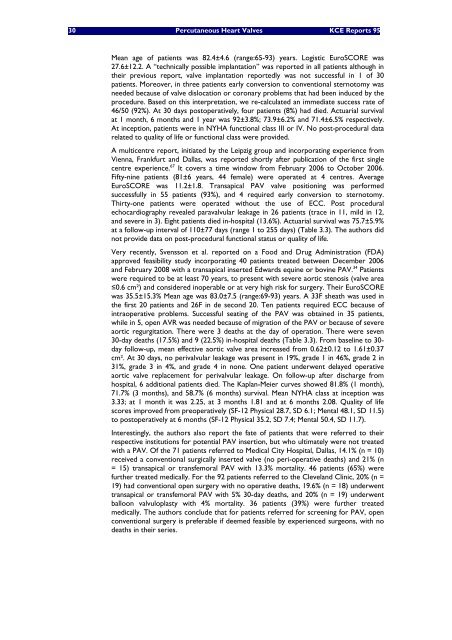Percutane hartklep implantatie bij congenitale en ... - KCE
Percutane hartklep implantatie bij congenitale en ... - KCE
Percutane hartklep implantatie bij congenitale en ... - KCE
Create successful ePaper yourself
Turn your PDF publications into a flip-book with our unique Google optimized e-Paper software.
30 <strong>Percutane</strong>ous Heart Valves <strong>KCE</strong> Reports 95<br />
Mean age of pati<strong>en</strong>ts was 82.4±4.6 (range:65-93) years. Logistic EuroSCORE was<br />
27.6±12.2. A “technically possible implantation” was reported in all pati<strong>en</strong>ts although in<br />
their previous report, valve implantation reportedly was not successful in 1 of 30<br />
pati<strong>en</strong>ts. Moreover, in three pati<strong>en</strong>ts early conversion to conv<strong>en</strong>tional sternotomy was<br />
needed because of valve dislocation or coronary problems that had be<strong>en</strong> induced by the<br />
procedure. Based on this interpretation, we re-calculated an immediate success rate of<br />
46/50 (92%). At 30 days postoperatively, four pati<strong>en</strong>ts (8%) had died. Actuarial survival<br />
at 1 month, 6 months and 1 year was 92±3.8%; 73.9±6.2% and 71.4±6.5% respectively.<br />
At inception, pati<strong>en</strong>ts were in NYHA functional class III or IV. No post-procedural data<br />
related to quality of life or functional class were provided.<br />
A multic<strong>en</strong>tre report, initiated by the Leipzig group and incorporating experi<strong>en</strong>ce from<br />
Vi<strong>en</strong>na, Frankfurt and Dallas, was reported shortly after publication of the first single<br />
c<strong>en</strong>tre experi<strong>en</strong>ce. 67 It covers a time window from February 2006 to October 2006.<br />
Fifty-nine pati<strong>en</strong>ts (81±6 years, 44 female) were operated at 4 c<strong>en</strong>tres. Average<br />
EuroSCORE was 11.2±1.8. Transapical PAV valve positioning was performed<br />
successfully in 55 pati<strong>en</strong>ts (93%), and 4 required early conversion to sternotomy.<br />
Thirty-one pati<strong>en</strong>ts were operated without the use of ECC. Post procedural<br />
echocardiography revealed paravalvular leakage in 26 pati<strong>en</strong>ts (trace in 11, mild in 12,<br />
and severe in 3). Eight pati<strong>en</strong>ts died in-hospital (13.6%). Actuarial survival was 75.7±5.9%<br />
at a follow-up interval of 110±77 days (range 1 to 255 days) (Table 3.3). The authors did<br />
not provide data on post-procedural functional status or quality of life.<br />
Very rec<strong>en</strong>tly, Sv<strong>en</strong>sson et al. reported on a Food and Drug Administration (FDA)<br />
approved feasibility study incorporating 40 pati<strong>en</strong>ts treated betwe<strong>en</strong> December 2006<br />
and February 2008 with a transapical inserted Edwards equine or bovine PAV. 34 Pati<strong>en</strong>ts<br />
were required to be at least 70 years, to pres<strong>en</strong>t with severe aortic st<strong>en</strong>osis (valve area<br />
≤0.6 cm²) and considered inoperable or at very high risk for surgery. Their EuroSCORE<br />
was 35.5±15.3% Mean age was 83.0±7.5 (range:69-93) years. A 33F sheath was used in<br />
the first 20 pati<strong>en</strong>ts and 26F in de second 20. T<strong>en</strong> pati<strong>en</strong>ts required ECC because of<br />
intraoperative problems. Successful seating of the PAV was obtained in 35 pati<strong>en</strong>ts,<br />
while in 5, op<strong>en</strong> AVR was needed because of migration of the PAV or because of severe<br />
aortic regurgitation. There were 3 deaths at the day of operation. There were sev<strong>en</strong><br />
30-day deaths (17.5%) and 9 (22.5%) in-hospital deaths (Table 3.3). From baseline to 30day<br />
follow-up, mean effective aortic valve area increased from 0.62±0.12 to 1.61±0.37<br />
cm². At 30 days, no perivalvular leakage was pres<strong>en</strong>t in 19%, grade 1 in 46%, grade 2 in<br />
31%, grade 3 in 4%, and grade 4 in none. One pati<strong>en</strong>t underw<strong>en</strong>t delayed operative<br />
aortic valve replacem<strong>en</strong>t for perivalvular leakage. On follow-up after discharge from<br />
hospital, 6 additional pati<strong>en</strong>ts died. The Kaplan-Meier curves showed 81.8% (1 month),<br />
71.7% (3 months), and 58.7% (6 months) survival. Mean NYHA class at inception was<br />
3.33; at 1 month it was 2.25, at 3 months 1.81 and at 6 months 2.08. Quality of life<br />
scores improved from preoperatively (SF-12 Physical 28.7, SD 6.1; M<strong>en</strong>tal 48.1, SD 11.5)<br />
to postoperatively at 6 months (SF-12 Physical 35.2, SD 7.4; M<strong>en</strong>tal 50.4, SD 11.7).<br />
Interestingly, the authors also report the fate of pati<strong>en</strong>ts that were referred to their<br />
respective institutions for pot<strong>en</strong>tial PAV insertion, but who ultimately were not treated<br />
with a PAV. Of the 71 pati<strong>en</strong>ts referred to Medical City Hospital, Dallas, 14.1% (n = 10)<br />
received a conv<strong>en</strong>tional surgically inserted valve (no peri-operative deaths) and 21% (n<br />
= 15) transapical or transfemoral PAV with 13.3% mortality. 46 pati<strong>en</strong>ts (65%) were<br />
further treated medically. For the 92 pati<strong>en</strong>ts referred to the Cleveland Clinic, 20% (n =<br />
19) had conv<strong>en</strong>tional op<strong>en</strong> surgery with no operative deaths, 19.6% (n = 18) underw<strong>en</strong>t<br />
transapical or transfemoral PAV with 5% 30-day deaths, and 20% (n = 19) underw<strong>en</strong>t<br />
balloon valvuloplasty with 4% mortality. 36 pati<strong>en</strong>ts (39%) were further treated<br />
medically. The authors conclude that for pati<strong>en</strong>ts referred for scre<strong>en</strong>ing for PAV, op<strong>en</strong><br />
conv<strong>en</strong>tional surgery is preferable if deemed feasible by experi<strong>en</strong>ced surgeons, with no<br />
deaths in their series.

















